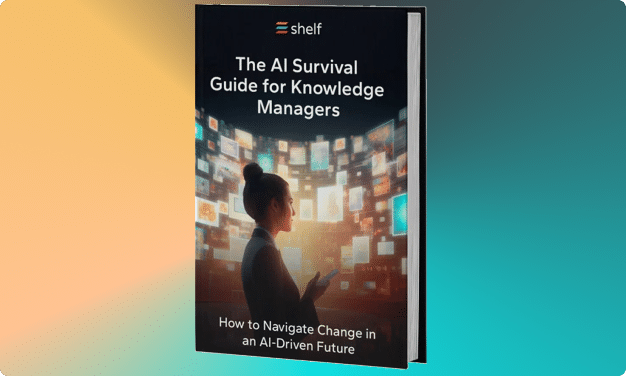One of the greatest methods for achieving better efficiency in your organization is to conduct a knowledge management assessment. There’s an entire industry around knowledge management (KM) and many organizations are discovering KM is integral to streamlining the roles and responsibilities of knowledge workers — especially with the rise of artificial intelligence (AI).
A knowledge management assessment is a simple audit of every knowledge-related component in your organization. This assessment discovers where there are gaps in your processes, team structure, or technology. Knowledge management assessments can be beneficial for businesses that require coordinating knowledge across the organization (such as contact centers) or when an AI-powered tool needs access to the organization’s knowledge base.
You may need to conduct a knowledge management assessment annually for any of the following reasons:
- Implementing a new knowledge management system
- Completing a significant corporate restructuring
- If customer support can’t find good answers
- To stay compliant with industry regulations
- Graduating from a knowledge base to an enterprise KM software
The goal of the assessment is to provide insight on how your current system is performing and identify areas where your organization needs to improve. This article will go over how to perform this assessment yourself.
Here are the five steps to follow for a knowledge management assessment:
Step 1
Review documented frameworks or systems in place
The first step to getting where you want to be is knowing where you are. Performing a comprehensive assessment of how people in your organization work together to maintain knowledge will provide the information you need.
Some questions you’ll want to answer include the following:
- What is your current process for sharing knowledge?
- Is your process documented and codified?
- How are you protecting classified or sensitive information? Do you have a knowledge governance policy?
- What is your knowledge-creation process? Is there a standard followed by everyone at your organization?
- How is knowledge distributed and accessed?
- What are your quality control procedures for creating and updating knowledge?
- How are knowledge updates distributed?
- How do you collect feedback on your information?
At Shelf, we’ve found these questions will reliably reveal vulnerabilities. We’ve worked with a lot of organizations — such as contact centers — that experienced significant improvement in their reporting metrics simply by addressing these questions.
For example, if your current process for sharing knowledge isn’t documented and codified you may experience long onboarding times for new hires. Similarly, if your knowledge creation process isn’t standardized and automated you could have a lot of inconsistencies within your data. Each of these problems can probably be resolved by individuals on their own, but when you’re scaling your operations you need a framework that outlines all procedures and describes each component of the system.
The best way to answer these questions is to speak to stakeholders within your organization. Conduct comprehensive interviews with staff at all levels, observe activities and data related to sharing knowledge, share questionnaires or surveys with your staff, or host a wider internal discussion.
Understanding how your own staff shares knowledge is especially important for organizations hoping to take advantage of AI solutions that require a knowledge base. If the employees who have worked for your organization for years can’t figure out your system, GenAI tools aren’t going to either.
Step 2
Determine and report all knowledge-related problems
Once you’ve reviewed the framework of your knowledge management system and spoken internally about the process, you can identify the problems to be resolved.
Depending on the number of problems, you may want to consider surveys or focus groups to understand which problems cause the greatest frustration. Alternatively, you could perform an assessment on which problem is affecting your metrics the most. Changing your process can take time, so it’s best to address the highest priorities first.
Most of these problems fit into one of the following buckets:
Findability
It doesn’t matter how extensive and accurate your knowledge is if your staff can’t find what they need. We’ve seen this most pronounced within contact centers. When new hires can’t traverse your knowledge base, their average handle times or time spent resolving queries will be very high.
A centralized database should include knowledge of all types. You might be one of the many organizations that has its knowledge spread out across various applications, databases, and folders which makes centralization seem impossible. Luckily, there are tools that can access this knowledge in its different places and act as a central point of knowledge without performing a laborious migration process.
Whether you use a tool or not, it is important to remove silos in your knowledge base. The extra time added to your staff navigating these different locations adds to inefficiency.
Inaccurate or out-of-date knowledge
Any system requires regular maintenance. You must regularly update to cull inaccurate and out-of-date data. Incorrect information is especially problematic if your agents share knowledge with your customers. If customers are given incorrect information, they will lose trust in your company. Worse, your employees will lose faith in your system.
This step is vital for organizations performing a knowledge management assessment for future adoption of AI solutions. Contradictory data or duplicates contribute to “hallucinations” that result in AI technology providing inaccurate or false information.
To resolve out-of-date knowledge, you can task your employees with keeping all documents up to date — or you could rely on KM technology that flags articles and other content types that aren’t helping your customers.
Knowledge tools disconnected from integrated systems
The ever-present adoption problem affects knowledge management too. You may be using knowledge management tools you’ve outgrown, or your employees may find them cumbersome and clunky. If your organization doesn’t find your knowledge software intuitive to use, they’ll rely on their own methods instead.
Knowledge management has gone through a transformation with the rise of AI. If you’re relying on KM best practices or tools from a number of years ago, now is a good time to consider if you’re getting everything you need.
Step 3
Assess your overall KM strategy
After gathering feedback from within your organization, you should take a moment to strategically assess your system. This is where it becomes useful to rank priorities or map out the investment needed to resolve problems.
You may discover the number of problems feels overwhelming. If you have multiple problems such as outdated software, several silos for knowledge, no documented process, and a short amount of time to turn things around then you may need to take a different approach.
You may want to hire a knowledge management consultant or graduate to enterprise knowledge management software. These options become more likely if your organization (and knowledge base) are very large.
Step 4
Identify existing knowledge management methodologies and best practices
To achieve long-term success managing your knowledge, it helps to have a playbook whenever integrating knowledge into your company’s existing workflows. This is where having a certified knowledge manager (or consultant) can be greatly beneficial.
For example, the Knowledge-Centered Service (KCS) methodology is a popular set of best practices for creating and maintaining knowledge management systems. One theme of this knowledge methodology is the concept of continuous improvement and the double loop process: this process includes two core concepts:
- Solve: Resolving requests, providing answers to those who need them
- Evolve: Continuous learning and improvement, including analyzing articles based on interactions
Even if your organization adopts a slightly different knowledge management methodology, the continuous cycle of answering, learning, and improving is important to keep knowledge usable and optimized.
Step 5
Identify gaps in knowledge
Once you’ve addressed the knowledge you already possess, you should identify gaps within your knowledge. This is most commonly missing articles, readability issues, missed titles, lacking taxonomy, or out-of-date information.
Missing knowledge
Is your organization routinely asking the same questions? This can be especially challenging for customer-facing departments such as contact centers. Customers may stumble upon an issue that doesn’t have a documented resolution — which can contribute to long handle times and inefficiency.
Artificial intelligence technology can be severely limited if you have gaps in your knowledge. Customers or agents may be frustrated when the AI technology can’t produce the right answer. This error can make it seem like your AI technology is failing you, when the cause is actually the management of your knowledge.
Modern knowledge management platforms can help automatically identify and help fill gaps in your knowledge to prevent these issues.
Personnel
Gaps in your knowledge management team can also negatively affect your KM system. You may find you need an additional technical admin or help from other departments. A few common knowledge responsibilities include:
- Knowledge manager
- Technical administrator
- Library subject matter expert
- Customer support supervisor
- Trainers
- Content creators
Software
The term “knowledge management” became popular during the 1980s as the workplace began its digital transformation and it received a second wind of interest in the 2000s. If your understanding of knowledge management is from either of these decades, it’s important to remember a lot has changed since then.
New knowledge management systems provide more functionality and features to resolve common problems such as gaps in knowledge, duplicates, or silos. The most advanced knowledge management systems are aware of AI’s reliance on knowledge management to function. If you find your current software unsatisfactory, create a list of requirements you need for your next software evaluation.
While a knowledge base or internal wiki can function well for small teams, many enterprises require an enterprise knowledge platform. This type of software is powerful enough to convert knowledge into an infrastructure.
What to know before you conduct a knowledge management assessment
No matter the steps you take, approach your next knowledge management assessment with a plan. Speak with operations, customer support agents, and executives to identify gaps you need to address.
A simple knowledge audit can reveal your KM system’s overall effectiveness and also identify gaps you need to shore up in people, processes, or technologies.
A KM assessment should be a routine process to ensure your knowledge management system is a well-oiled machine that can provide up-to-date, accurate, and trusted knowledge to customers and employees.
Before you begin, get your copy of Knowledge Management for the Enterprise, an annual report by DMG Consulting for ideas about what to include in your next KM system revamp. Good luck!





